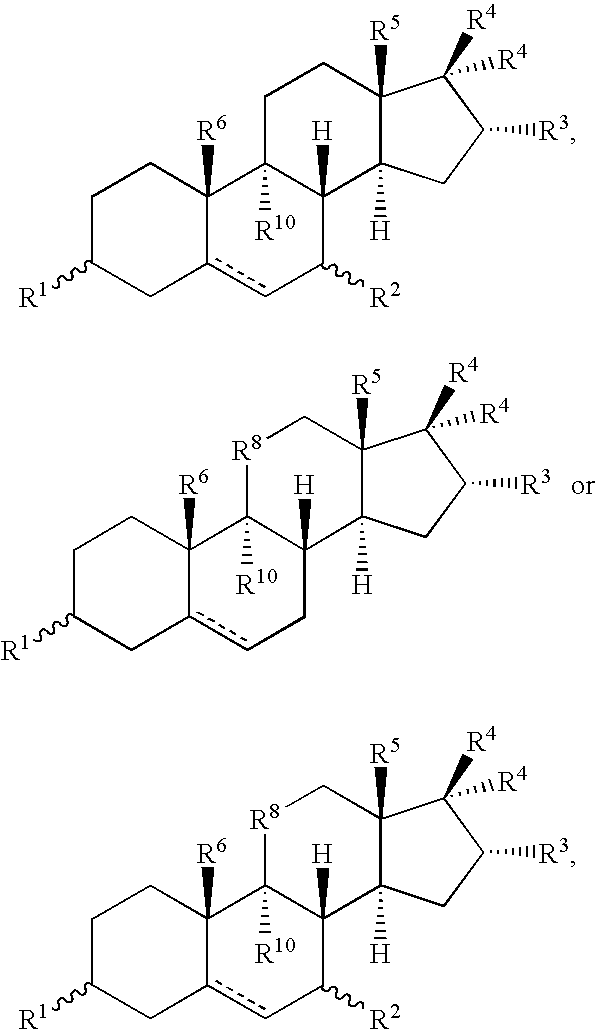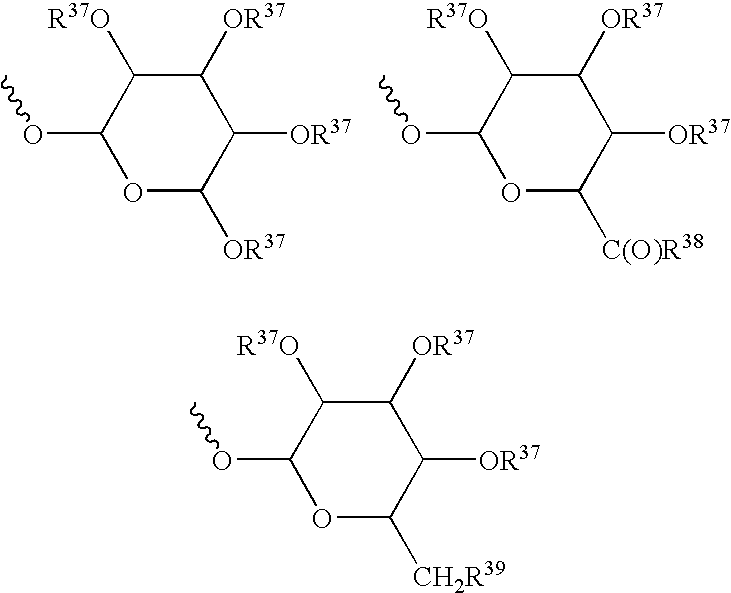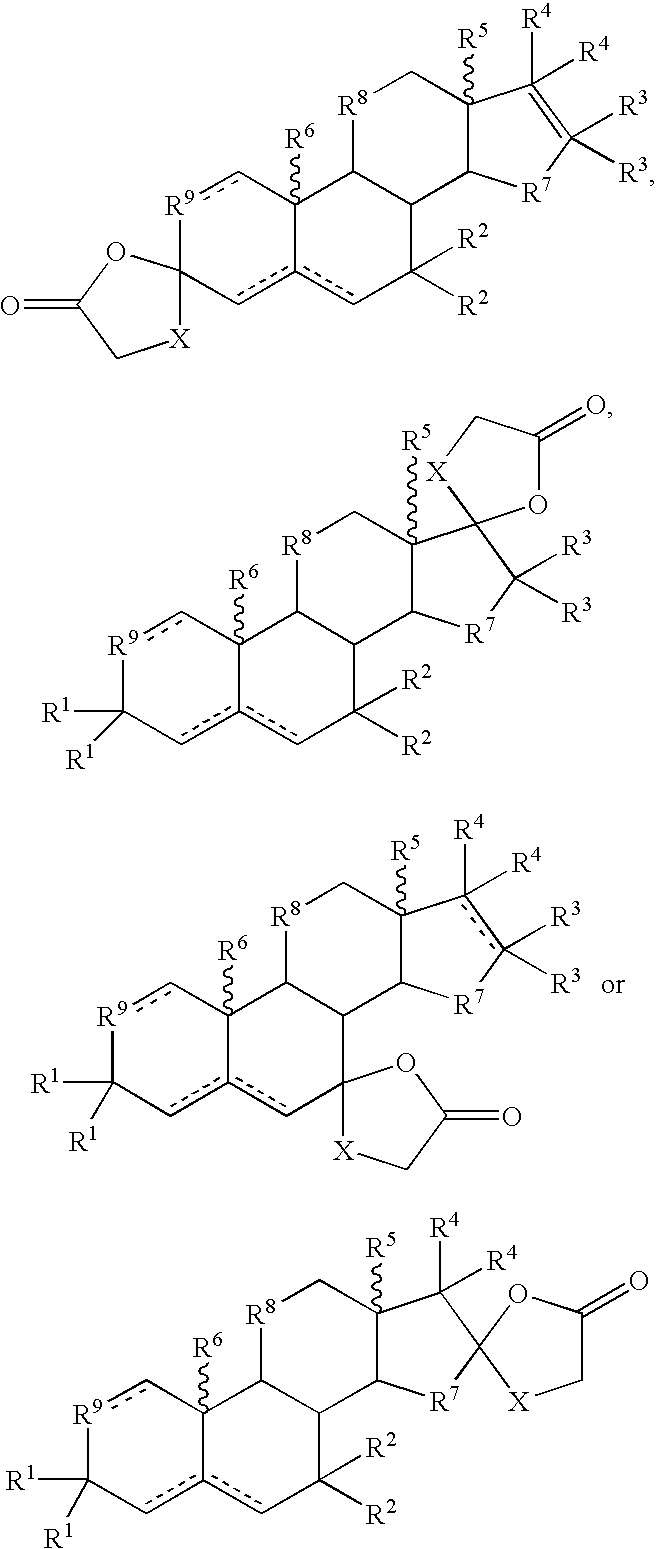Metabolic Disease Treatments
a technology for metabolic diseases and treatment methods, applied in the field of metabolic disease treatment, can solve the problems of increased burden on the pancreas, increased complications, and increased number of diabetic patients and patients suffering from complications thereo
- Summary
- Abstract
- Description
- Claims
- Application Information
AI Technical Summary
Problems solved by technology
Method used
Image
Examples
example 1
[0490] Glucose lowering and amelioration of insulin resistance. Glucose lowering effects and amelioration of insulin resistance was assessed in the diabetic db / db mouse model of human diabetes and insulin resistance.
[0491] In these studies, db / db C57BL / Ks mice of approximately 8 to 10 weeks of age were divided into groups of 10 each and then treated with a vehicle control (no drug) or 17α-ethynylandrost-5-ene-3β,7β,17β-triol by oral gavage. The compound was administered twice a day at 20 mg / kg / day (10 mg / kg dose administered twice per day), 40 mg / kg / day (20 mg / kg dose administered twice per day) or 80 mg / kg / day (40 mg / kg dose administered twice per day) for up to 28 days. Blood glucose levels were monitored twice a week during the dosing period, using a minute amount of blood (nick tail bleeds) to measure the concentration of glucose by glucometer strips. At specific times during the dosing period (day 14 and day 28), an oral glucose tolerance test (OGTT) was also performed by admi...
example 2
[0492] Diet induced obesity (DIO) mouse hyperglycemia treatment. The effect of a drug to enhance peripheral sensitivity to insulin can be studied in a mouse model in which a state of insulin resistance is attained by feeding the animals a fat-enriched diet (60% of total caloric intake) for at least 6 weeks. This model has been described, e.g., J. N. Thupari et al., Proc. Natl. Acad. Sci. USA, 99(14):9498-9502, 2002, H. Xu et al., J. Clin. Invest., 112:1821-1830, 2003, H. Takahashi et al., J. Biol. Chem., 278(47):46654-46660, 2003. Under these diet conditions, the mice exhibit increased body weight (+35 g) and a state of glucose intolerance, which is manifested as a significant delay in the clearance time of orally-administered glucose during a standard OGTT.
[0493] For these studies, animals of approximately 4 weeks of age were divided into groups of 10 animals each and then treated with a vehicle control (no drug) or 17α-ethynylandrost-5-ene-3β,7β,17β-triol by oral gavage. The 17α-...
example 3
[0494] A treatment protocol similar to that described in example 1 was performed with db / db mice that were younger than the animals described in example 2. The animals (n=8 to 10 per group) were treated with 17α-ethynylandrost-5-ene-3β,7β,17β-triol or vehicle by oral gavage twice per day at 40 mg / kg / day (20 mg / kg dose given twice per day) and 80 mg / kg / day (40 mg / kg dose given twice per day). At the start of dosing, the animals were 6 weeks of age, before the onset of elevated glucose levels or hyperglycemia. Dosing with vehicle or drug was maintained for 32 days to determine the effect of the treatments on the onset and rate of progression of hyperglycemia in the animals. In the control group, the onset of hyperglycemia was observed after 25 days of dosing and it continued to worsen, i.e., blood glucose levels rose from normal to frank hyperglycemia, through the end of the 32 day dosing period. By contrast, levels of glucose in both drug treatment groups did not rise above normal le...
PUM
 Login to View More
Login to View More Abstract
Description
Claims
Application Information
 Login to View More
Login to View More - R&D
- Intellectual Property
- Life Sciences
- Materials
- Tech Scout
- Unparalleled Data Quality
- Higher Quality Content
- 60% Fewer Hallucinations
Browse by: Latest US Patents, China's latest patents, Technical Efficacy Thesaurus, Application Domain, Technology Topic, Popular Technical Reports.
© 2025 PatSnap. All rights reserved.Legal|Privacy policy|Modern Slavery Act Transparency Statement|Sitemap|About US| Contact US: help@patsnap.com



